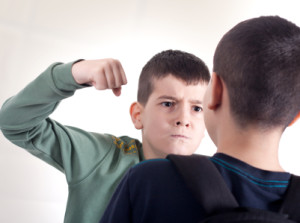 Series: Part 1 of 3
Series: Part 1 of 3
Last week, we looked at the stereotypes of bullies and the real people who end up being bullies. Here’s a question we haven’t asked: How does bullying affect the bully? The effects of bullying on the victim are better known. We tend to give less thought to how the bully might be affected by their own behavior.
Recent research published in JAMA Psychiatry sheds light on the longer-term effects of bullying on bullies, targets, and bully-targets (kids who are both bullies and targets). Whatever the role played, bullying puts kids at risk for numerous psychiatric issues, including depression, anxiety, panic disorders, suicidal thinking or behavior, and agoraphobia (fear of open spaces, crowds, or situations that may be difficult to escape from). These problems persisted through young adulthood (age 26), the age limit of the study.
This study of 1,400 kids, ages 9-16, with follow up to age 26, found that being a target raised the risk factor 3-5 times for psychological problem. Bullies had some additional and different risks, demonstrating a 4-5 times increased risk for anti-social personality disorder (described as a lack of empathy, lying, and criminal behavior). Earlier studies have shown that as bullies grow up, they tend to have more problems holding down jobs, more problems in relationships, more issues with drugs and alcohol, and are more likely to have police records. Bully-targets suffer the most severe and widest-ranging consequences. They run a 5-fold risk of depression and a 10-25 fold risk of various panic disorders.
So how can adults help prevent or minimize this risk for long term damage? As we’ve said before, school is not the cause of bullying behavior, and schools are sometimes unfairly blamed for kids’ bullying. The potential for bullying is a characteristic of all social groups and adults must lead the way to provide guidance for kids. Everyone can be and should be responsible for creating and maintaining safe and welcoming environments in our schools, homes, and communities.
Here are some tips. Our tips focus on the school environment, but apply equally to whatever environment you’re trying to change:
- Intervene Early To Stop Bullying In Its Tracks. This is the key to preventing further bullying and the damage it causes. Kids must know that “No Bullying” applies every day, even and especially when you’re in conflict with another child or children.
- Identify Behaviors And Social Skills That Need To Change, For Bullies, Targets, Bully-Targets, And Bystanders (don’t forget the bystanders!). It’s not just about the kids. Adults must identify and change our own behaviors that enable and scaffold bullying, even if we are not immediately aware of what we’re doing that’s allowing bullying to thrive.
- Make A Plan. Write down the desired changes and goals for individuals and groups and routinely review your progress against these goals. Individual Education Plans (IEPs) can be and have been used for this purpose, for example to help children who are bullying work with consistent structure, goals, and adult guidance towards behavior change and skill acquisition. Ask the child for their cooperation and what adults and peers can do to help them reach their goals. School-wide plans can tackle the changes needed to the environment to make it inhospitable to bullying. Identify action items by group (teachers, students, staff, and other support people). Involve parents by identifying things they can do at home to support the changes being asked for at school.
- Review Progress Frequently. Set regular check-in dates where the child can report progress and adults can offer encouragement and support. Review schoolwide progress at weekly or monthly staff meetings.
Early intervention doesn’t mean the problem will disappear overnight. Adults must be both consistent and insistent about the behavioral changes we are seeking. Depending on the urgency in your environment, be prepared to sustain frequent, low-level monitoring for months and make the commitment that maintaining a peaceful, friendly, welcoming school will require permanent, low-level monitoring. Commit to early intervention on the part of adult and child bystanders when mistakes get made and bullying reappears. The guidance we give our kids pays benefits for a better school environment for kids and adults today and helps us all to a happier future.
References:
W Copeland, et al, “Adult Psychiatric Outcomes of Bullying and Being Bullied by Peers in Childhood and Adolescence,” JAMA Psychiatry, 70(4):419-426, Feb 2013
A Sourander, et al, “Childhood Bullies and Victims and Their Risk of Criminality in Late Adolescence,” Archives of Pediatrics And Adolescent Medicine, 161(6), Jun 2007
Photo credit: istockphoto.com


3 comments
3 pings
i am looking at this for a school essay
Hi I was bullied for 10 years
I hated it
I was laughed at
I know my bully is looking at this
I want to say
I think I will be a bully
I’ll get her back
Ok
Agreed
I hope so
Bye
Launa
As someone who bullied a girl when I was 6 to 9 I find myself hating myself because of it
[…] « How Does Bullying Affect the Bully? […]
[…] recent weeks, our close-up lens has focused on how bullying affects the bully and how bullying affects bystanders. Today, let’s look at some shocking (but predictable) ways […]
[…] face later on can be a lack of confidence and self hate because of the bullying. In an article by Laura Blume she states, “ Bullies have some additional risk demonstrating a 4-5 time increased risk of […]